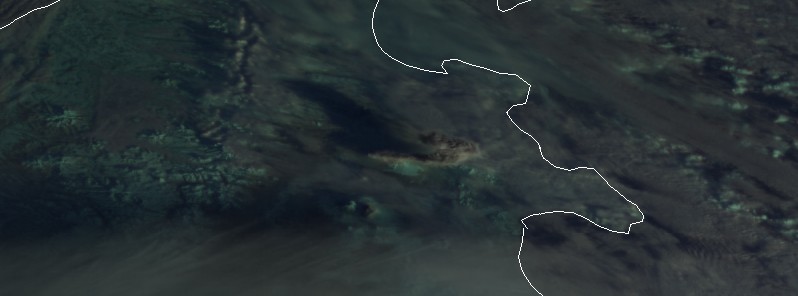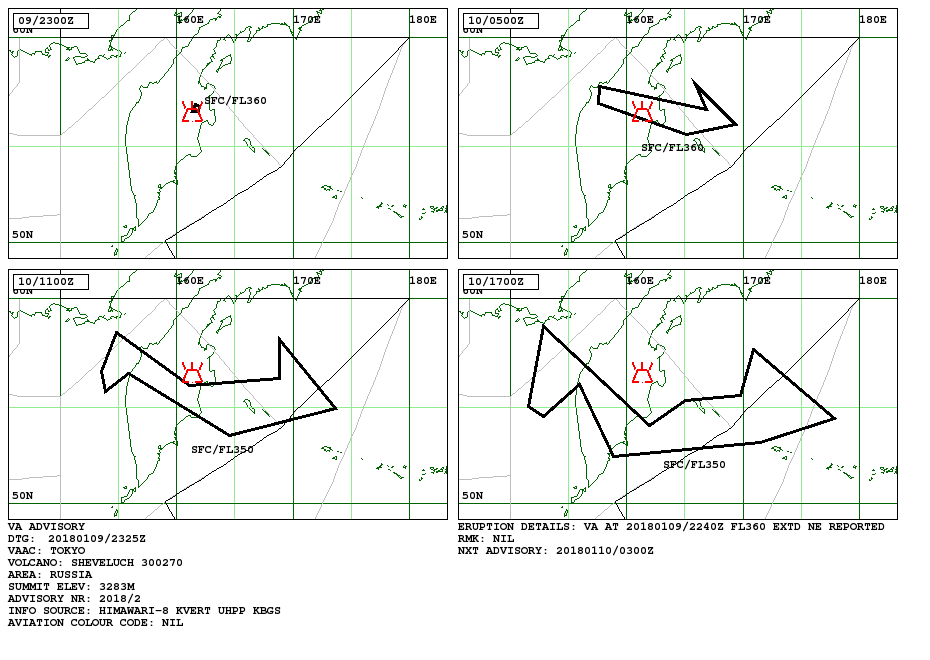Strong explosion at Sheveluch ejects ash up to 11 km (36 000 feet), Aviation Color Code Red

A powerful explosive eruption occurred at Russia's Sheveluch volcano at 22:40 UTC on January 9, 2018, ejecting a plume of ash up to 11 km (36 000 feet) above sea level.
The eruption forced authorities to raise the Aviation Color Code from Orange to Red. The eruptive column is not visible in webcam imagery due to a meteorological cloud.
Ash plume/cloud is drifting to the northeast of the volcano and reaching an altitude of 11 km (36 000 feet) above sea level, based on Himawari-8 satellite data (below).
Ash explosions up to 10 – 15 km (32 800 – 49 200 feet) a.s.l. could occur at any time, KVERT said. Ongoing activity could affect international and low-flying aircraft, the observatory warned.

The last time this volcano had Aviation Color Code raised to Red was on July 23, 2017. At the time, ash was reaching an altitude of 12 km (39 360 feet) a.s.l.
Geological summary
The high, isolated massif of Sheveluch volcano (also spelled Shiveluch) rises above the lowlands NNE of the Kliuchevskaya volcano group. The 1 300 km3 (311.9 mi3) volcano is one of Kamchatka's largest and most active volcanic structures. The summit of roughly 65 000-year-old Stary Shiveluch is truncated by a broad 9-km-wide late-Pleistocene (5.6 miles) caldera breached to the south. Many lava domes dot its outer flanks. The Molodoy Shiveluch lava-dome complex was constructed during the Holocene within the large horseshoe-shaped caldera; Holocene lava dome extrusion also took place on the flanks of Stary Shiveluch.
At least 60 large eruptions have occurred during the Holocene, making it the most vigorous andesitic volcano of the Kuril-Kamchatka arc. Widespread tephra layers from these eruptions have provided valuable time markers for dating volcanic events in Kamchatka. Frequent collapses of dome complexes, most recently in 1964, have produced debris avalanches whose deposits cover much of the floor of the breached caldera. (GVP)
Featured image: Plume of ash rising above Sheveluch volcano at 23:00 UTC on January 9, 2018, 20 minutes after explosion. Credit: JMA/Himawari-8

Commenting rules and guidelines
We value the thoughts and opinions of our readers and welcome healthy discussions on our website. In order to maintain a respectful and positive community, we ask that all commenters follow these rules:
We reserve the right to remove any comments that violate these rules. By commenting on our website, you agree to abide by these guidelines. Thank you for helping to create a positive and welcoming environment for all.